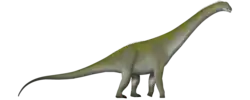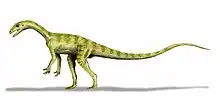Chucarosaurus
Chucarosaurus (meaning "indomitable reptile") is an extinct genus of titanosaurian dinosaur from the Late Cretaceous (middle Cenomanian–lower Turonian) Huincul Formation of Argentina. The genus contains a single species, C. diripienda, known from various limb and pelvic bones.[1]
| Chucarosaurus Temporal range: Late Cretaceous, | |
|---|---|
 | |
| Skeletal diagram of Chucarosaurus | |
| Scientific classification | |
| Domain: | Eukaryota |
| Kingdom: | Animalia |
| Phylum: | Chordata |
| Clade: | Dinosauria |
| Clade: | Saurischia |
| Clade: | †Sauropodomorpha |
| Clade: | †Sauropoda |
| Clade: | †Macronaria |
| Clade: | †Titanosauria |
| Clade: | †Lithostrotia |
| Clade: | †Colossosauria |
| Genus: | †Chucarosaurus Agnolin et al., 2023 |
| Species: | †C. diripienda |
| Binomial name | |
| †Chucarosaurus diripienda Agnolin et al., 2023 | |
Discovery and naming
The Chucarosaurus holotype specimen, MPCA PV 820, was discovered in sediments of the Huincul Formation, dated to the middle Cenomanian–lower Turonian ages of the late Cretaceous period, at Pueblo Blanco Natural Reserve in Río Negro Province, Argentina. The specimen consists of a complete left humerus, partial left radius, complete left metacarpal II, left ischium, partial left femur and fibula, partial right tibia, and partial indeterminate metapodial, all of which belong to one individual. An additional specimen (MPCA PV 821), consisting of a left femur and tibia, was assigned as the paratype.[1]
In 2023, Agnolin et al. described Chucarosaurus diripienda, a new genus and species of colossosaurian titanosaurs, based on these fossil remains. The generic name, "Chucarosaurus", combines "chucaro", a Quechua word meaning "hard and indomitable animal" with the Latin word "saurus", meaning "reptile". The specific name, "diripienda", is derived from a Latin word meaning "scrambled".[1]
Description
Chucarosaurus was a large, slender-limbed titanosaur. Its femur was roughly 1.9 metres (6.2 ft) long, somewhat smaller than the estimated 2.5 metres (8.2 ft) length of the femur of Argentinosaurus. The forelimb was shorter than the hindlimb, with a humerus 78% the length of the femur, as is typical of titanosaurs but unlike some basal titanosauriforms such as brachiosaurids. As in other colossosaurs, the deltopectoral crest of the humerus was thickened in its distal half. The ischium has a shorter, more robust iliac peduncle than in other titanosaurs.[1]
Classification

Agnolin et al. (2023) recovered Chucarosaurus as a colossosaurian member of the Titanosauria, as the sister taxon to a clade formed by Notocolossus and the Lognkosauria. The results of their phylogenetic analyses are shown in the cladogram below:[1]
| Colossosauria |
| |||||||||||||||||||||||||||||||||||||||||||||||||||||||||
Palaeoenvironment

Chucarosaurus is known from the Late Cretaceous Huincul Formation of Río Negro Province, Argentina. Many dinosaurs, including fellow titanosaurs (Argentinosaurus and Choconsaurus), rebbachisaurids (Cathartesaura and Limaysaurus),[2] carcharodontosaurids (Mapusaurus, Meraxes, and Taurovenator), a megaraptoran (Aoniraptor), abelisaurids (Skorpiovenator, Tralkasaurus, and Ilokelesia), an elaphrosaurine (Huinculsaurus),[3] a paravian (Overoraptor), and the unusual avetheropod Gualicho have also been named from the formation.[4][5] Remains of unenlagiids, iguanodonts, and elasmarian ornithopods are also known.[1]
References
- Agnolin, Federico L.; Gonzalez Riga, Bernardo J.; Aranciaga Rolando, Alexis M.; Rozadilla, Sebastián; Motta, Matías J.; Chimento, Nicolás R.; Novas, Fernando E. (2023-02-02). "A new giant titanosaur (Dinosauria, Sauropoda) from the Upper Cretaceous of Northwestern Patagonia, Argentina". Cretaceous Research: 105487. doi:10.1016/j.cretres.2023.105487. ISSN 0195-6671.
- Calvo, Jorge O.; Salgado, Leonardo (1995). "Rebbachisaurus tessonei sp. nov. a new Sauropoda from the Albian-Cenomanian of Argentina; new evidence on the origin of the Diplodocidae" (PDF). Gaia. 11: 13–33. Archived from the original (PDF) on 23 September 2021.
- Baiano, Mattia A.; Coria, Rodolfo A.; Cau, Andrea (June 2020). "A new abelisauroid (Dinosauria: Theropoda) from the Huincul Formation (lower Upper Cretaceous, Neuquén Basin) of Patagonia, Argentina". Cretaceous Research. 110: 104408. doi:10.1016/j.cretres.2020.104408. S2CID 214118853.
- Cerroni, M.A.; Motta, M.J.; Agnolín, F.L.; Aranciaga Rolando, A.M.; Brissón Egli, F.; Novas, F.E. (2020). "A new abelisaurid from the Huincul Formation (Cenomanian-Turonian; Upper Cretaceous) of Río Negro province, Argentina". Journal of South American Earth Sciences. 98: 102445. Bibcode:2020JSAES..9802445C. doi:10.1016/j.jsames.2019.102445. S2CID 213781725.
- Matías J. Motta; Federico L. Agnolín; Federico Brissón Egli; Fernando E. Novas (2020). "New theropod dinosaur from the Upper Cretaceous of Patagonia sheds light on the paravian radiation in Gondwana". The Science of Nature. 107 (3): Article number 24. Bibcode:2020SciNa.107...24M. doi:10.1007/s00114-020-01682-1. hdl:11336/135530. PMID 32468191. S2CID 218913199.











